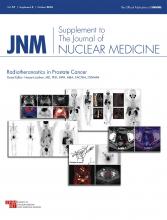Abstract
The prostate-specific membrane antigen (PSMA) has received increased consideration during the past few years as an excellent target for both imaging and therapy of prostate cancer. After many years of outstanding preclinical research, the first significant step forward in clinical use was achieved in 2008 with the first human experience with the small-molecule PSMA inhibitors 123I-MIP-1972 and 123I-MIP-1095. A clinical breakthrough followed in 2011 with 68Ga-PSMA-11 for PET imaging and 131I-MIP-1095 for endoradiotherapy of metastatic prostate cancer. Since then, PET/CT with 68Ga-PSMA-11 has rapidly spread worldwide, and endoradiotherapy with PSMA ligands has been conducted at increasing numbers of centers. 68Ga-PSMA-11 is currently the subject of multicenter studies in different countries. Since 2013, 131I-related PSMA therapy has been replaced by 177Lu-labeled ligands, such as PSMA-617, which is also the subject of multicenter studies. Alternative PSMA ligands for both imaging and therapy are available. Among them is 99mTc-MIP-1404, which has recently entered a phase 3 clinical trial. This article focuses on the highlights of the development and clinical application of PSMA ligands.
- © 2016 by the Society of Nuclear Medicine and Molecular Imaging, Inc.







